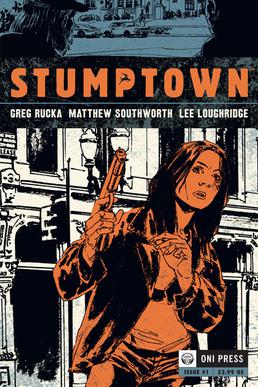"The Secret Ingredient Is Crime" - Ed Brubaker
One of the great things about writer Greg Rucka and artist Matthew Southworth's stylish take on the P.I. genre-driven tale of a flawed detective, a girl gone missing, and a deal gone wrong is that it embraces and adheres to the classic pulpy crime story. More than that, however, is that much like its counterpart Criminal, Stumptown is another example of how the comics medium continues to not only breathe life into the crime story genre conventions that first came to be in the early to mid period of twentieth century fiction and film, but also are able to define it for the medium of comics in a unique way. I believe this unique-ness is accomplished to a large degree through color and use of space and place.
There is Life in the Body, You Just Gotta Know How to Breathe Life Into It
Even working within the blueprint of a genre and how those stories flow, it is hard to craft an entertaining, engrossing and compelling narrative. If it was easy, more would do it, but if you have ever tried to write your own superhero story, or book about aliens, or even romance, you know that even within the blueprints of what is taught to us in grade school English/Drama about story construction (act structure, rising action, climax, etc.), and getting from point "a"------>"b" is no easy feat! The medium of comics helps artists, writers and creators work within genre conventions (e.g. the detective crime story) while allowing a greater freedom to explore in really unrestricted ways. In the comics medium, as long as you hit the universal story beats, then you can play with the way your story looks on the page, thus creating new and modern interpretations.
This Place Feels Really Familiar
So is Stumptown= Portland, Oregon? Well yes and no. Much like the best fictions, Stumptown is based on a real place. According to the introduction by Matt Fraction in the first collected edition of Stumptown, the layouts and backgrounds are indeed Portland, and to a very vivid degree. This is another example of how comics are able to inhabit a real space and yet it be just a little adjusted where it is its own world (for more on this idea, see these posts here and here). Stumptown creates this blend of real and imaginary through a specific color palette that is naturalistic and stays very close to groundwork laid in another homage series, Criminal by writer Ed Brubaker and artist Sean Phillips. For this example, lets do a compare and contrast by looking at the night scenes in figures one and two below. Comics medium artists such as Phillips (figure 1) and Southworth (figure 2) along with also the unsung colorist for these series such as Val Staples for the most recent Criminal and Lee Loughridge for Stumptown, are creating a great twist on a genre style employed in the shadow-y colors of blue, purple/violet, and dark shadow outlines enhanced through backlighting. Much like the classic ideas about black and white film noir, shadows and light are just as important (perhaps even more so) in the comics world of trying to create mood, environment, and really establishing a place or time period as character.
 |
| Fig.1 |
 |
| Fig. 2 |
So who influences who more in the crime genre-- the books, the movies, or the comics? I like to think that through these stories there is a very homogenous blend that is forming that is part homage, part convention, and part new territory as is the want of the creative team. Stumptown is more what I like to think of as "wide-screen" cinematic than say Criminal because it is taking place in a more open area, as opposed to the claustrophobia of the city in Criminal. It is fascinating to think about environment in relation to story in this way because one cannot deny the importance of the spatial aspects as character in such instances. While film and television sometimes moves to fast for us to soak in such nuances as place, the comics medium is able to slow us down and have us really soak in the places that these stories inhabit. While Phillips and Southworth obviously have a lot of respect for each other they (along with the co-creators/writers Brubaker and Rucka respectively) are both helping to create the unique space within the comics medium for the detective crime story to find new legs and new audiences.
Stumptown is copyrighted to Greg Rucka and Matthew Southworth; Criminal is copyrighted to Ed Brubaker and Sean Phillips. Figures provided by the author were purchased by the author and are intended only for academic/conversational purposes.

No comments:
Post a Comment